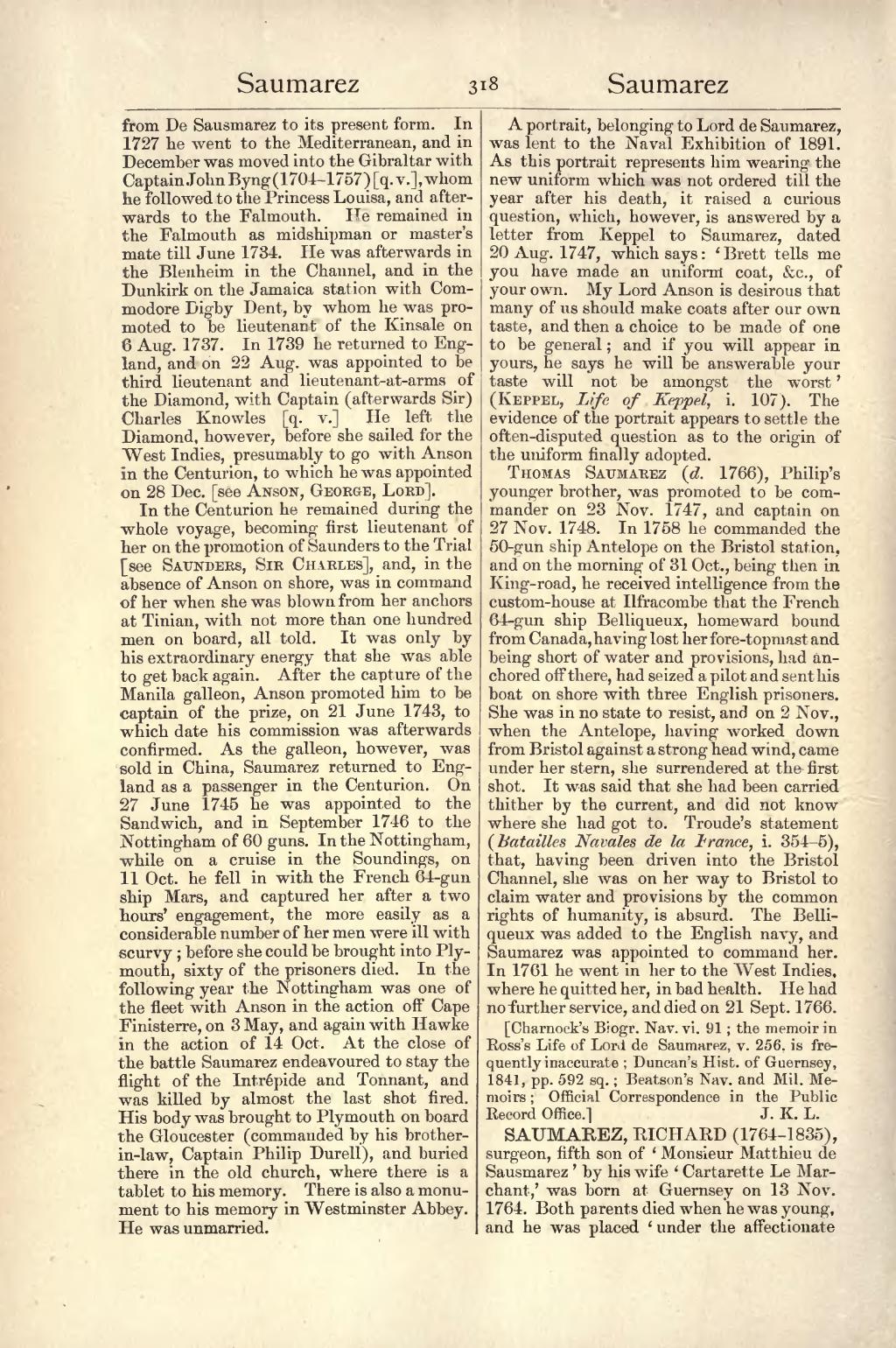from De Sausmarez to its present form. In 1727 he went to the Mediterranean, and in December was moved into the Gibraltar with Captain John Byng (1704–1757) [q. v.], whom he followed to the Princess Louisa, and afterwards to the Falmouth. He remained in the Falmouth as midshipman or master's mate till June 1734. He was afterwards in the Blenheim in the Channel, and in the Dunkirk on the Jamaica station with Commodore Digby Dent, by whom he was promoted to be lieutenant of the Kinsale on 6 Aug. 1737. In 1739 he returned to England, and on 22 Aug. was appointed to be third lieutenant and lieutenant-at-arms of the Diamond, with Captain (afterwards Sir) Charles Knowles [q. v.] He left the Diamond, however, before she sailed for the West Indies, presumably to go with Anson in the Centurion, to which he was appointed on 28 Dec. [see Anson, George, Lord].
In the Centurion he remained during the whole voyage, becoming first lieutenant of her on the promotion of Saunders to the Trial [see Saunders, Sir Charles], and, in the absence of Anson on shore, was in command of her when she was blown from her anchors at Tinian, with not more than one hundred men on board, all told. It was only by his extraordinary energy that she was able to get back again. After the capture of the Manila galleon, Anson promoted him to be captain of the prize, on 21 June 1743, to which date his commission was afterwards confirmed. As the galleon, however, was sold in China, Saumarez returned to England as a passenger in the Centurion. On 27 June 1745 he was appointed to the Sandwich, and in September 1746 to the Nottingham of 60 guns. In the Nottingham, while on a cruise in the Soundings, on 11 Oct. he fell in with the French 64-gun ship Mars, and captured her after a two hours' engagement, the more easily as a considerable number of her men were ill with scurvy; before she could be brought into Plymouth, sixty of the prisoners died. In the following year the Nottingham was one of the fleet with Anson in the action off Cape Finisterre, on 3 May, and again with Hawke in the action of 14 Oct. At the close of the battle Saumarez endeavoured to stay the flight of the Intrépide and Tonnant, and was killed by almost the last shot fired. His body was brought to Plymouth on board the Gloucester (commanded by his brother-in-law, Captain Philip Durell), and buried there in the old church, where there is a tablet to his memory. There is also a monument to his memory in Westminster Abbey. He was unmarried.
A portrait, belonging to Lord de Saumarez, was lent to the Naval Exhibition of 1891. As this portrait represents him wearing the new uniform which was not ordered till the year after his death, it raised a curious question, which, however, is answered by a letter from Keppel to Saumarez, dated 20 Aug. 1747, which says: ‘Brett tells me you have made an uniform coat, &c., of your own. My Lord Anson is desirous that many of us should make coats after our own taste, and then a choice to be made of one to be general; and if you will appear in yours, he says he will be answerable your taste will not be amongst the worst’ (Keppel, Life of Keppel, i. 107). The evidence of the portrait appears to settle the often-disputed question as to the origin of the uniform finally adopted.
Thomas Saumarez (d. 1766), Philip's younger brother, was promoted to be commander on 23 Nov. 1747, and captain on 27 Nov. 1748. In 1758 he commanded the 50-gun ship Antelope on the Bristol station, and on the morning of 31 Oct., being then in King-road, he received intelligence from the custom-house at Ilfracombe that the French 64-gun ship Belliqueux, homeward bound from Canada, having lost her fore-topmast and being short of water and provisions, had anchored off there, had seized a pilot and sent his boat on shore with three English prisoners. She was in no state to resist, and on 2 Nov., when the Antelope, having worked down from Bristol against a strong head wind, came under her stern, she surrendered at the first shot. It was said that she had been carried thither by the current, and did not know where she had got to. Troude's statement (Batailles Navales de la France, i. 354–5), that, having been driven into the Bristol Channel, she was on her way to Bristol to claim water and provisions by the common rights of humanity, is absurd. The Belliqueux was added to the English navy, and Saumarez was appointed to command her. In 1761 he went in her to the West Indies, where he quitted her, in bad health. He had no further service, and died on 21 Sept. 1766.
[Charnock's Biogr. Nav. vi. 91; the memoir in Ross's Life of Lord de Saumarez, v. 256, is frequently inaccurate; Duncan's Hist. of Guernsey, 1841, pp. 592 sq.; Beatson's Nav. and Mil. Memoirs; Official Correspondence in the Public Record Office.]
SAUMAREZ, RICHARD (1764–1835), surgeon, fifth son of ‘Monsieur Matthieu de Sausmarez’ by his wife ‘Cartarette Le Marchant,’ was born at Guernsey on 13 Nov. 1764. Both parents died when he was young, and he was placed ‘under the affectionate
